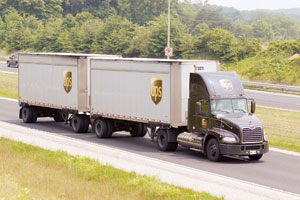Managing Editor, Features and Multimedia
Trailer Makers Are Ready to Supply 33-Foot Doubles

This story appears in the July 13 print edition of Transport Topics.
Most major trailer manufacturers said they would expect to see an immediate surge of demand for 33-foot twin trailers, should the government approve their use for U.S. roads. They also said they would be ready to build the longer doubles as soon as fleets begin submitting orders.
Congress is considering legislation that would extend the maximum length of pup trailers from 28 to 33 feet, a change that could boost productivity for less-than-truckload and parcel fleets.
If the longer equipment gains approval, Wabash National Corp. would expect to see strong de-mand at the outset, said Robert Lane, director of business development for its Commercial Trailer Products unit.
“When considering both the economic and environmental benefits, along with road congestion reduction, we would expect that most, if not all, LTL fleets would want to take advantage of this opportunity — where it makes sense — as soon as made available,” he said.
Other manufacturers also foresee a potentially abrupt shift in the market.
Chris Hammond, executive vice president of sales at Great Dane Trailers, said the industry would likely see an immediate “bump up” in production to meet the initial demand for 33-foot trailers, before eventually shifting to a replacement cycle.
David Giesen, vice president of sales and marketing at Stoughton Trailers, said he, too, would expect strong early demand as fleets look to take advantage of the added productivity by placing significant quantities of the longer trailers into service.
“We would expect most customers that order 28-foot trailers today to order 33-foot [trailers], going forward,” he said.
“There should be fairly significant near-term boost in demand,” added Glenn Harney, chief sales officer at Hyundai Translead. “Discussions we have had up to now indicate a quick move to get them into the fleets.” He cautioned, however, that it’s not yet known what types of limitations might come with the legislation.
Whatever the details, the proposed rule likely will not provide a landslide of new business to Utility Trailer Manufacturing Co., said Craig Bennett, senior vice president of sales and marketing. Utility builds very few dry-van doubles trailers, he said, and he noted that doubles reefer trailers represent only a limited section of the industry due to the cost of reefer units and other accessories.
Time also could be a factor for broad industry adoption. Michael Scheid, senior analyst at SJ Consulting, estimated that it would take more than 10 years for fleets that can use 33-foot trailers to make the complete switch to the longer units, though some could do it sooner if they had the money.
Trailer makers said they already have completed the necessary design and engineering work to bring the longer pup trailers to market. Wabash National, for one, exhibited a 33-foot pup trailer at the Technology & Maintenance Council’s 2014 annual meeting.
“We are ready to deliver 33-foot pup trailers when needed by our customer base,” said Wabash’s Lane.
Great Dane also has designs in place for 33-foot trailers and is capable of building them now, Hammond said.
“[Stoughton] will be able to build these orders as soon as they come in,” Giesen said.
Harney said Hyundai Translead also would be prepared to begin building the longer trailers soon, depending on the availability of production capacity.
Manufacturers see the longer trailers as a benefit to their customers.
“With the current focus on increasing freight capacity, reducing road congestion and improving fuel economy, we believe that extending the length of a trailer makes sense,” Lane said.
Stoughton’s Giesen said 33-foot trailers would represent a significant productivity gain because operators can haul two more rows of “normal sized” pallets when compared to a 28-foot pup.
“In short, our customers want this and we want this for them,” he said.
Utility’s Bennett said 33-foot doubles would be good and are supported by LTL fleets, but he added that the change would be “just a baby step in the world of productivity that is available.”
“My attitude is that there are more efficient doubles configurations available, such as 40-foot [trailers], all the way up to 53-footers that are being used today in North America,” he said.
Hyundai Translead’s Harney said it’s not yet clear what percentage of fleets that currently use 28-foot trailers would make the switch to longer pups.
Many customers would begin ordering the 33-foot trailers in lieu of 28-foot units, but the extra space would not be a benefit for fleets that don’t fill a 28-foot trailer at a particular location, or for operations where the existing pup trailers already weight out, he said, adding that dry vans would likely benefit from the extra length more than other trailer types, including refrigerated trailers.
Giesen said fleets that use liftgate trailers or deal with tight delivery spaces also may choose to continue with 28-foot trailers.
Senior Reporter Rip Watson contributed to this story.

